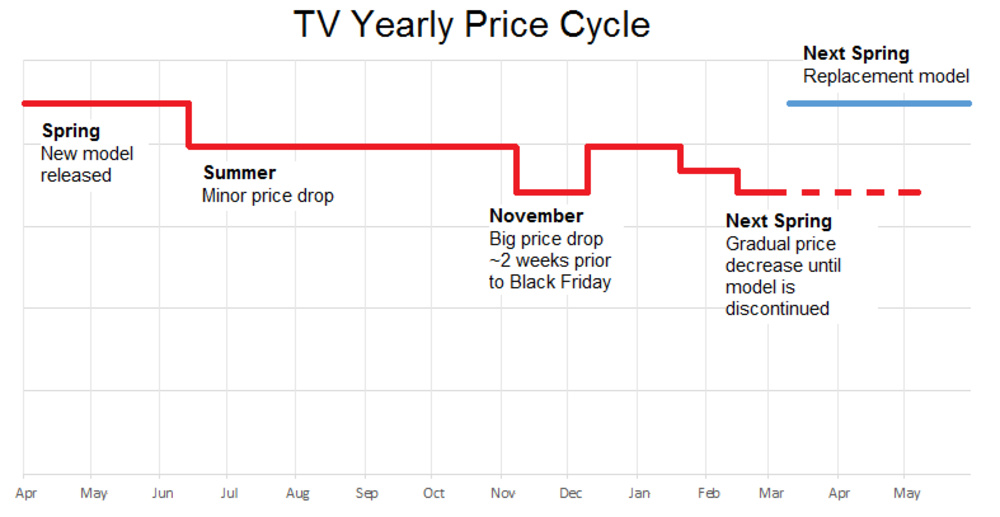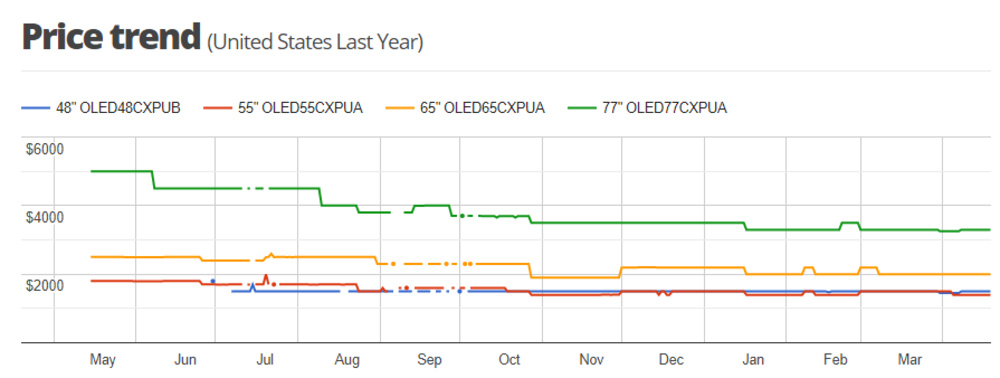- Table of Contents
- Intro
- Finding The Best Deal
- Where To Get A Good Deal
- Conclusion
- Comments
The Best Times of Year to Buy a TV
Unlike some other tech devices, TV models aren’t meant to be sold for multiple years. The majority of TVs are released, sold for about a year, and then discontinued when the next year’s models come out.
If you want to be on the cutting edge, the best time to buy a TV is in spring/early summer, when the bulk of the year’s new models are released. If you’re a bargain hunter, there are better times of the year to make your purchase.
Here's a simplified chart that illustrates and approximates how a TV's price changes over the course of a year.

Finding The Best Deal
Every year, most brands release most of their new lineup in the spring. Thanks to minor deals here and there, those TVs will typically fluctuate down and back up in price for a few months, with a slight overall decrease over that time. Most will get a large cut a couple of weeks before Black Friday and the holiday shopping season.
By the new year, they go back up to about where they were pre-holiday and then see a few cuts throughout the following months, leading up to the release of the new models in spring and early summer. Then, you’ll again see a large decrease, mainly because these TVs are discontinued.
For a specific example, take a look at this more detailed chart of the price fluctuation of the LG CX from its release in spring 2020 to its replacement by the C1 in April 2021.

The same trends are consistent for most TVs, meaning that the overall best times of the year to buy a TV are around the holiday shopping season, and then once the next year’s models are being released. For an even better deal, you could also wait longer, until well after the next year’s models have been released, as prices for older models will usually continue to drop. Just keep in mind that by doing this, you run the risk of the model you want selling out forever.
Where To Get A Good Deal
ALL RETAILERS HAVE THE SAME PRICE
Several TV manufacturers - including Samsung, Sony, Sharp, and LG - have a Unilateral Pricing Policy. This means they set the prices that their TVs are sold at in every store. Typically, this means every store selling a given TV model will be selling it for the same price as all the other stores.
Legally, retailers don't have to honor this policy, and they can set their prices lower if they wish to do so. Legally the manufacturers can refuse to do business with retailers that refuse to comply with the UPP; this is why all major retailers do.
These UPP policies are also why recent years have seen fewer unique sales on televisions than in years past. Chances are that if a TV is on sale at Amazon, it’s also on sale for the same amount at other retailers like Target or Best Buy.
Some brands, like Vizio and Panasonic, don’t have this policy. This means you can sometimes find actual sales on those TVs (as well as other non-UPP brands).
FAKE DEALS
If you see a retailer you're unfamiliar with is selling a TV for much lower than the competition, the chances are good that the deal isn’t genuine or comes with a big catch.
Here's a typical example. A website is selling two 'versions' of the same TV - usually a Samsung, but it can be any brand - and the two versions are called something like the 'NA/domestic' version and the 'AU/CA/international' version. Typically, the latter is a good deal cheaper - expect to see the NA/domestic version marked up. Though any difference between the two is generally left unclear by the listings, the implication is that the AU/CA/international version is the better buy.
This sort of deal isn't genuine and often plays out this way: after the sale, the seller urges the buyer of the cheaper model to 'upgrade' to the more expensive option and, if the customer refuses, the sale is canceled. In short, this false comparison is nothing more than an upselling trick designed to get people to pay more money for a particular TV.
So, as a rule of thumb, if you see a particular TV is only on sale at one location, be suspicious. If you see there's an 'alternate version' on sale at that location for a very different price, don’t bother buying from that store.
To shop with confidence, make sure you buy from an authorized retailer of the brand you're looking at. For the brands that we review, full lists are available at the following links.
Warehouse models
Many TV manufacturers also offer warehouse models (like Costco and Sam's Club) for a slightly lower price. Most of these TVs should perform the same as the units we've tested, but there are often some slight cosmetic differences. Some brands, like Samsung, also offer different speaker configurations in their warehouse models, but not always. These models usually have slightly different model numbers; this is so the retailer can avoid having to price match with other retailers. For example, most recent Samsung TVs replace the "0" in the model with a "D", so "Q7DT" instead of the "Q70T".
 Warehouse variants for the Samsung Q70T.
Warehouse variants for the Samsung Q70T.Conclusion
While there are occasional deals on TVs throughout the year, people who want a bargain should do two things: buy their TV during the holiday shopping season or right when the next year’s replacement models are coming out in the spring and buy from a reputable dealer. Doing both of these things will ensure you get a good price on the TV you want, and also that you don’t have to deal with shady business practices.











































